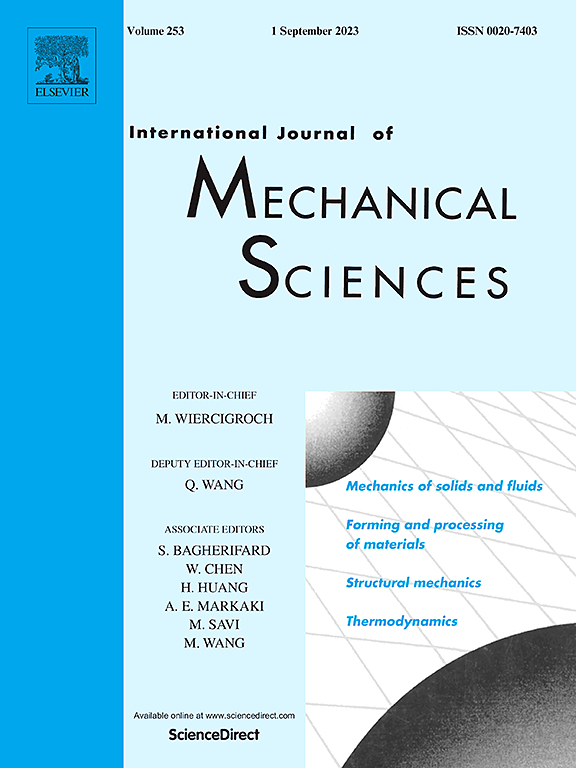Manipulating defects in metallic glasses via ultrasonic treatment
IF 7.1
1区 工程技术
Q1 ENGINEERING, MECHANICAL
International Journal of Mechanical Sciences
Pub Date : 2025-02-01
DOI:10.1016/j.ijmecsci.2025.109960
引用次数: 0
Abstract
Flow defects play an important role in shaping the mechanical behaviors of metallic glasses (MGs), especially their plastic deformation. Characterizing or manipulating these defects in MGs is of a great challenge due to the absence of the long-range order. In this work, we systematically investigated the defect activation mechanism of the La55Al25Ni5Cu10Co5 medium-entropy MG under ultrasonic treatment (UT) from perspectives of order and electronic structure. The finding reveals that the ordered configurations inherited from the liquid state intend to unravel after UT, meanwhile the atomic packing rejuvenates to a more disordered loose state even though the structural ordering interrupts at high injected energies, which ultimately contributes to the strong defect relaxation with longer characteristic times as evidenced by a generalized Maxwell-Voigt model. The 27Al nuclear magnetic resonance (NMR) confirms the redistribution of local clusters around Al sites during UT, along with the bonding characteristics evolving from a covalent-like to predominantly metallic state, and then towards covalent-like nature again accompanied with ordering. Simultaneously activated defects enhance the mechanical heterogeneity with the remarkable decrease of hardness and elastic modulus, thereby more significant plastic flow under multiscale defect activation. Our work provides new perspectives for dexterously modulating the plastic deformability of MGs and potentially sheds new light on the deformation mechanism of amorphous materials.

求助全文
约1分钟内获得全文
求助全文
来源期刊

International Journal of Mechanical Sciences
工程技术-工程:机械
CiteScore
12.80
自引率
17.80%
发文量
769
审稿时长
19 days
期刊介绍:
The International Journal of Mechanical Sciences (IJMS) serves as a global platform for the publication and dissemination of original research that contributes to a deeper scientific understanding of the fundamental disciplines within mechanical, civil, and material engineering.
The primary focus of IJMS is to showcase innovative and ground-breaking work that utilizes analytical and computational modeling techniques, such as Finite Element Method (FEM), Boundary Element Method (BEM), and mesh-free methods, among others. These modeling methods are applied to diverse fields including rigid-body mechanics (e.g., dynamics, vibration, stability), structural mechanics, metal forming, advanced materials (e.g., metals, composites, cellular, smart) behavior and applications, impact mechanics, strain localization, and other nonlinear effects (e.g., large deflections, plasticity, fracture).
Additionally, IJMS covers the realms of fluid mechanics (both external and internal flows), tribology, thermodynamics, and materials processing. These subjects collectively form the core of the journal's content.
In summary, IJMS provides a prestigious platform for researchers to present their original contributions, shedding light on analytical and computational modeling methods in various areas of mechanical engineering, as well as exploring the behavior and application of advanced materials, fluid mechanics, thermodynamics, and materials processing.
 求助内容:
求助内容: 应助结果提醒方式:
应助结果提醒方式:


